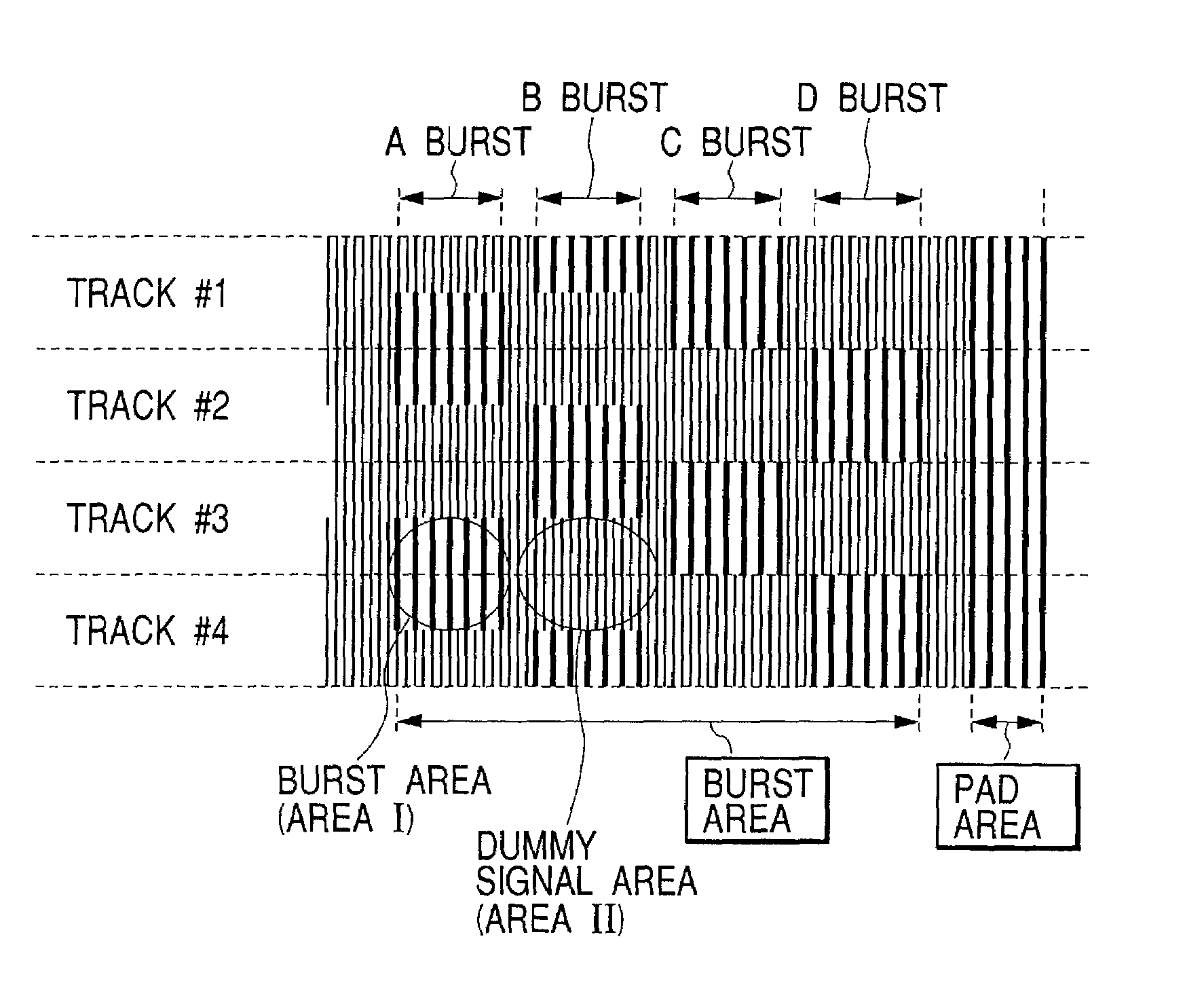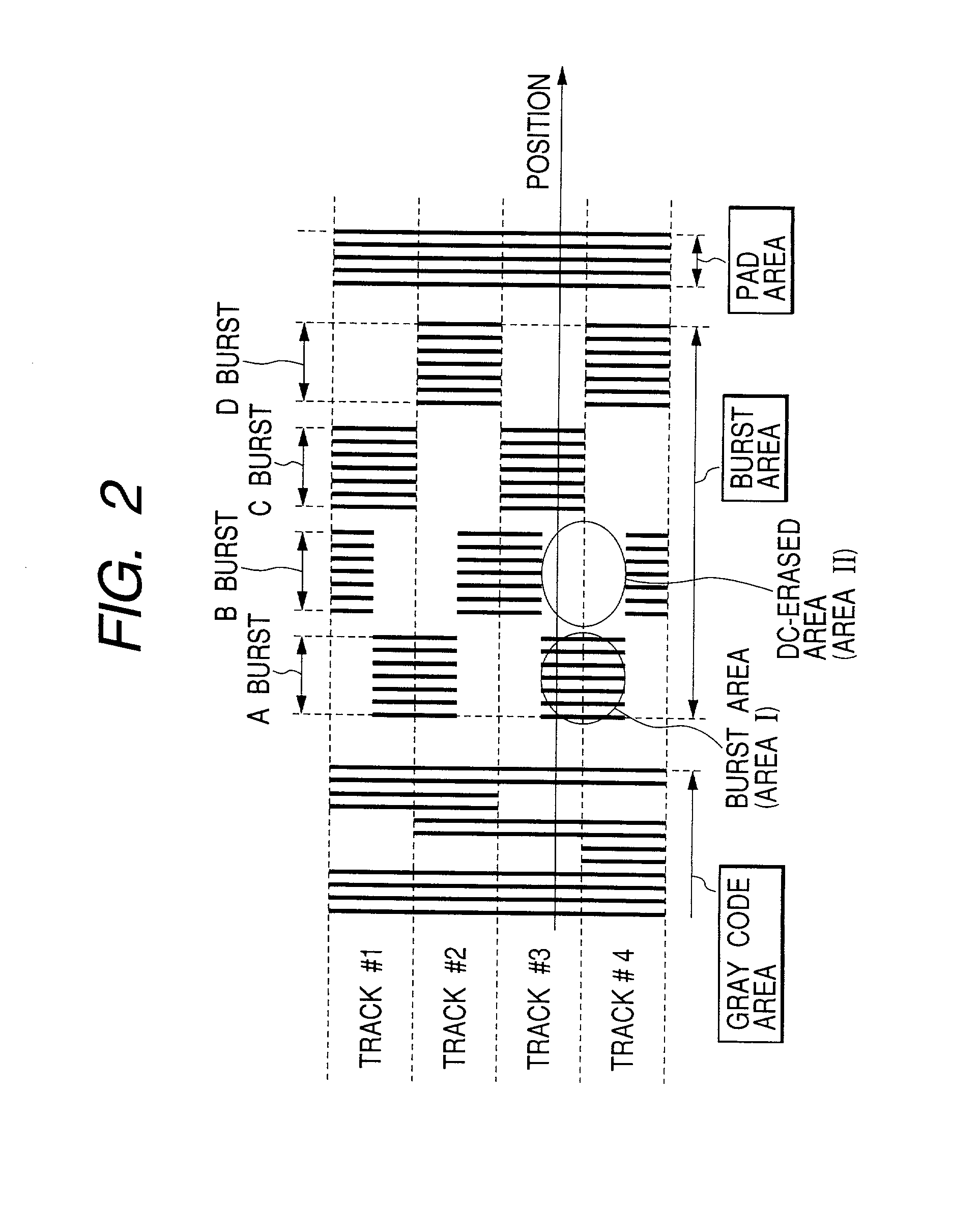Method of servo writing for magnetic recording system, magnetic recording system
a technology of magnetic recording system and servo writing, which is applied in the direction of digital recording, maintaining head carrier alignment, instruments, etc., can solve the problems of deteriorating position signal quality, affecting the stability of the position signal, so as to improve the anti-signal decay performance, reduce the demagnetization field in the servo area, and improve the servo signal quality
- Summary
- Abstract
- Description
- Claims
- Application Information
AI Technical Summary
Benefits of technology
Problems solved by technology
Method used
Image
Examples
first embodiment
[0046]A first embodiment will be explained. According to this embodiment, there is provided a longitudinal magnetic recording system in which a pattern having a recording density twice as high as the burst signal, i.e. having a bit length one half that of the burst signal is recorded in an area which has conventionally been a DC erased area (area II in FIG. 2), i.e. a dummy area, as shown in FIG. 1.
[0047]The steps of forming the burst area with a servo writer will be explained with reference to FIGS. 3(a) to 3(e) and 4(f) to 4(i). As in the conventional longitudinal recording system, a burst pattern is formed at pitches of one half track. In what has conventionally been the DC erased area, however, a pattern having bits one half of the burst signal area is recorded. As a result, a burst pattern of hound's tooth check is formed on both sides of the dummy signal area.
[0048]FIG. 5 shows an outline of the servo system configuration. The longitudinal magnetic recording system also often ...
second embodiment
[0051]A second embodiment will be explained. According to this embodiment, the steps of forming the burst area are exactly the same as those of the first embodiment, but the servo signal processing system is different. FIG. 8 shows an outline of the processing system. Unlike the first embodiment in which the amplitude is calculated by integrating the absolute value, the present embodiment is such that the frequency component is detected (phase is detected) by use of DFT (Discrete Fourier Transform) thereby to control the position signal. The phase is detected by the frequency but not by the amplitude of the servo signal and that the frequency of the dummy area is different from that of the burst signal area. Therefore, the frequencies of the dummy area and the burst signal area can be discriminated readily. Thus, the LPF for the servo area is eliminated, and a LPF similar to that for the data area can be used.
third embodiment
[0052]A third embodiment will be explained. According to this embodiment, the steps of forming the burst area and the servo signal processing system are exactly the same as those of the second embodiment. In this embodiment, however, the recording density of the burst signal area is subjected to certain conditions. As described above, the thermal demagnetization of the low-density signal is large in perpendicular recording. That portion of the recorded data on the media which has the lowest recording density, therefore, most easily-succumbs to the thermal fluctuation. According to this embodiment, the burst signal is recorded with a bit length shorter than the maximum bit length limited by the recorded code in the data area.
[0053]This embodiment uses a code having the efficiency of 32 / 33 in which 33 recorded bits are assigned to 32 user data bits as a recorded code. With this code, the longest recorded bits are ten times as long as the shortest recorded bits. The magnetic recording ...
PUM
| Property | Measurement | Unit |
|---|---|---|
| width | aaaaa | aaaaa |
| area | aaaaa | aaaaa |
| length | aaaaa | aaaaa |
Abstract
Description
Claims
Application Information
 Login to View More
Login to View More - R&D
- Intellectual Property
- Life Sciences
- Materials
- Tech Scout
- Unparalleled Data Quality
- Higher Quality Content
- 60% Fewer Hallucinations
Browse by: Latest US Patents, China's latest patents, Technical Efficacy Thesaurus, Application Domain, Technology Topic, Popular Technical Reports.
© 2025 PatSnap. All rights reserved.Legal|Privacy policy|Modern Slavery Act Transparency Statement|Sitemap|About US| Contact US: help@patsnap.com



